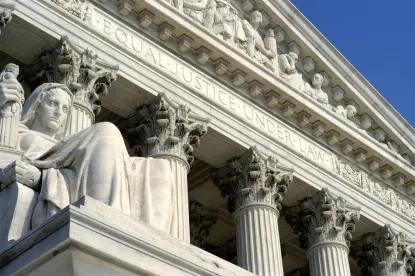On Monday, May 4, 2020, for the first time in its 231-year history, the Supreme Court heard oral arguments through a telephone conference call, allowing the attorneys to present arguments while complying with shelter-in-place orders. The case, U.S. Patent and Trademark Office v. Booking.com, No. 19-46, is also historically significant, given that it is the first time the Supreme Court has heard arguments on the issue of generic trademarks since the enactment of the Lanham Act in 1946. The non-visual nature of the telephone conference necessitated procedural changes to how the Justices and arguing attorneys could interact, requiring additional oversight by Chief Justice Roberts to direct the questioning and attempt to avoid inevitable cross-talk and instances of dead air by either the Justices or the arguing attorneys. Given the indefiniteness of the COVID-19 pandemic, this oral argument – even beyond addressing important aspects of trademark law – will likely serve as a model and prototype for future oral arguments conducted telephonically, including a number to be held over the next week at the Supreme Court.
The unique nature of the proceedings led to a structured format in which the Justices spoke in order of seniority, with Chief Justice Roberts asking his questions first and thereafter acting essentially as a panel moderator. The Chief Justice appeared to decide for his fellow Justices when the arguing attorney should be cut-off, carefully managing the time for the entire group of lawyers and Justices who were each remotely located at different locations. Although each Justice had the time to ask multiple questions, no Justice spoke during another’s turn, and did not ask any follow-up questions once their turn was over. These changes were likely necessary given the realities of conference calls, where the slight lag between speaking and being heard, combined with the lack of cues from body language, often lead to overlapping voices and confusion. However, the procedure is likely to have further effects. For example, Justice Thomas posed questions during oral arguments for the first time in over a year. As another example, the format may also increase the power of the Chief Justice, who held considerable sway over the flow of the questioning. Additionally, the format discouraged the Justices from interrupting each other, and seemed to decrease the degree to which the Justices tended to interrupt the arguing attorneys. The decrease in interruptions may be beneficial going forward, as the format allowed the Justices and the arguing attorneys – Erica Ross on behalf of the government and Lisa Blatt on behalf of Booking.com – to finish their thoughts and questions with minimal interruption.
On the merits, the case presents the question of “whether the addition by an online business of a generic top-level domain (“.com”) to an otherwise generic term can create a protectable trademark.” Generic terms are words that serve as common names used to describe goods or services, such as the term “computers” when used in connection with computing devices. This is contrasted with descriptive terms, which describe features or characteristics of those goods or services, such as “fast” or “powerful” when used to describe computers. Generic terms cannot be registered as trademarks, while descriptive terms may be registered if they acquire secondary meaning. There was no dispute that “booking,” when used with respect to booking services, was a generic term; the dispute revolves around whether the combined term “BOOKING.COM” was necessarily generic as well.
The U.S. Patent and Trademark Office (“USPTO”) argued, through the government attorney, that the addition of a top-level domain such as .com or .org to a generic mark would necessarily result in a generic term, other than certain minor exceptions where the top-level domain created a particular meaning, such as “tennis.net.” This argument was based on a decision from the 19th century, Goodyear’s India Rubber Glove Mfg. Co. v. Goodyear Rubber Co., 128 U.S. 598 (1888), in which the Supreme Court found that the addition of the word “Company” to a generic term resulted in a generic term. The Justices were skeptical of the application of the proposed categorical rule to the modern-day internet, noting that the Lanham Act itself identified a “primary significance” test that should be used for determining questions of genericness. Chief Justice Roberts challenged the government as to why they should rely on the 19th century case instead of the express language of the Lanham Act. Both Justices Kagan and Gorsuch probed the government attorney as to how the Court should rule if it rejected the categorical rule, possibly hinting as to their current thoughts on the matter.
On the other side of the issue, the Justices also questioned whether trademark rights were necessary at all to protect Booking.com’s investment in its URL. The government and some of the Justices noted that the use of a generic name such as “booking” in the URL had likely led to significant advantages, as consumers unaware of the company who simply typed “booking.com” into their web browsers would be directed to the company’s page. When pressed as to why Booking.com felt it needed a trademark registration despite acknowledging that the mark was “weak” at best, the arguing attorney noted that certain relief was available in the Lanham Act only for registered marks, such as to prevent outright counterfeiting or to seize URLs. In rebuttal, the government pointed out that standard unfair competition claims could generally provide relief for these circumstances, and therefore as a policy matter it was not necessary to provide trademark protection for “generic.com”-type names.
As with many of the changes implemented by the judicial branch to adapt to the COVID-19 pandemic, oral arguments presented over conference calls will create both problems and opportunities. Practitioners set to argue via conference call would be wise to take extra care to make sure their technology is sound and the audio quality is sufficiently high, and to allow extra time before speaking to avoid potential interruptions. However, some of the necessary changes may also provide unanticipated advantages over current norms. As courts continue to hear oral arguments telephonically and revise their protocols, the arguments may become increasingly productive and some of the changes being implemented may carry forward even after the pandemic has ended.





 />i
/>i

